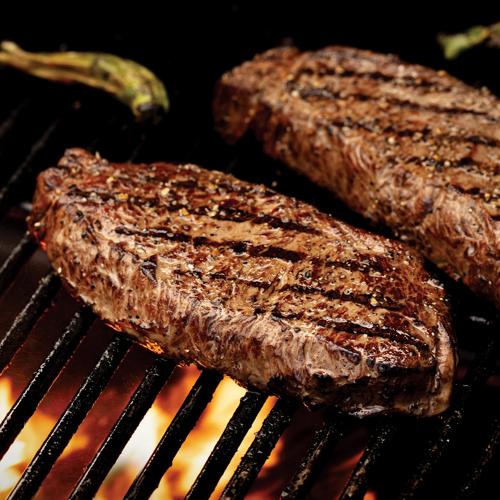Want the secret to cooking the perfect steak every time? With over 100 years of steak experience at Omaha Steaks, we’ve mastered the art of the steak cooking. And you can, too. Take the guesswork out of steak doneness with this steak doneness guide and temperature chart.
It’s easy to cook a juicy, delicious steak using nearly any cooking method. Whether you like it rare, medium rare, or medium, this guide will help you cook it just how you like it every time. You can get steakhouse-worthy results at home.
Steak Doneness Guide
Doneness affects the texture, flavor, and juiciness of your finished steak. These are Omaha Steaks chef-tested secrets to cooking the perfect steak every time.
Bring your steak to room temperature before cooking for best results. Just defrost using our steak thawing guide (there is even a fast thaw if you forget to defrost the night before.) Then, use this temperature chart to cook to your desired doneness.

Steak Temperatures
We recommend medium rare for most steaks, but you may prefer a different doneness. Here’s how the different steak temps and doneness will affect the flavor and texture.
Rare – 120°F
Rare steak has cool-to-warm red center, and soft, tender texture. This is an excellent choice for leaner steaks like top sirloin or filet mignon that don’t have as much fat to melt.
Medium Rare -130°F
Medium rare steak will have warm red center – perfect steak texture with a nice brown crust. Cooking to medium rare allows the fat (marbling in the steak) to render and add buttery, rich flavors to your steak. This is the ideal doneness for a juicy, flavorful steak.
Medium – 140°F
Steak cooked to a medium steak temperature will have a hot pink center and slightly firmer texture. The longer cooker time will make your steak slightly drier and the bite less tender.
Medium Well -150°F
Medium well steak will have a mostly brown center and firm texture. The meat will be drier as water evaporates during the cooking process.
Well Done – 160°+F
A well done steak will have no color left, will be very firm and much drier. The meat loses fat and moisture as it cooks, resulting in a dry, tougher texture. We don’t recommend cooking to this doneness.
How to Tell When Steak is Done
A great number of factors can affect cooking time and cooked steak levels. Appliances may vary and weather or altitude can all change the speed at which a steak cooks. Our cooking charts are as accurate as possible with a controlled cook at a consistent cooking temperature. However, because of influences beyond your control, the best way to gauge steak doneness is to measure the internal temperature of your steak with an accurate thermometer.
Test for doneness by inserting an instant-read thermometer through the side of the thickest part of the steak for an accurate temperature reading, be sure not touch bone or fat. Use our steak doneness chart to cook to the desired temperature.
Rest Your Steak
For a juicy, delicious steak, it needs to rest 3-5 minutes. This will help the juices redistribute for the best-tasting and juiciest steaks. Keep in mind, the temperature of your steak may increase up to 5 degrees as it rests. Top with a simple compound butter for an amazing steak dinner.

Practice Makes Perfect
Learning to control your cook doesn’t happen overnight. Cook steak regularly to learn your unique appliances or grills and you’ll be a steak cooking master in no time. Bonus – you get to enjoy more steak dinners while you practice!
More Like This

Full Steak Collection
Each steak is aged at least 28 days and hand-carved by master butchers.

18 Steakhouse Recipes
Bring the steakhouse to your house whenever the craving hits with our chef-created recipes.

The Ultimate Guide to Cooking Steak
This guide will give you the confidence to cook the perfect steak indoors or outdoors every time.




